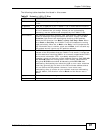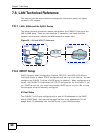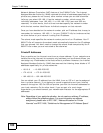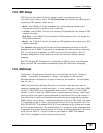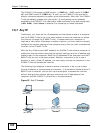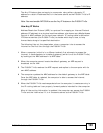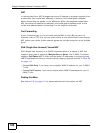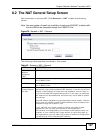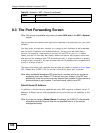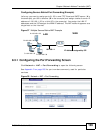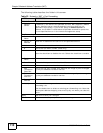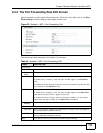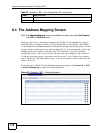
P-660H-T1v3s User’s Guide
105
CHAPTER 8
Network Address Translation
(NAT)
8.1 Overview
This chapter discusses how to configure NAT on the P-660H-T1v3s. NAT (Network
Address Translation - NAT, RFC 1631) is the translation of the IP address of a host
in a packet, for example, the source address of an outgoing packet, used within
one network to a different IP address known within another network.
8.1.1 What You Can Do in the NAT Screens
•Use the NAT General Setup screen (Section 8.2 on page 107) to configure the
NAT setup settings.
•Use the Port Forwarding screen (Section 8.3 on page 108) to configure
forward incoming service requests to the server(s) on your local network.
•Use the Address Mapping screen (Section 8.4 on page 112) to change your P-
660H-T1v3s’s address mapping settings.
•Use the SIP ALG screen (Section 8.5 on page 115) to enable and disable the
SIP (VoIP) ALG in the P-660H-T1v3s.
8.1.2 What You Need To Know About NAT
Inside/Outside
Inside/outside denotes where a host is located relative to the P-660H-T1v3s, for
example, the computers of your subscribers are the inside hosts, while the web
servers on the Internet are the outside hosts.
Global/Local
Global/local denotes the IP address of a host in a packet as the packet traverses a
router, for example, the local address refers to the IP address of a host when the
packet is in the local network, while the global address refers to the IP address of
the host when the same packet is traveling in the WAN side.



